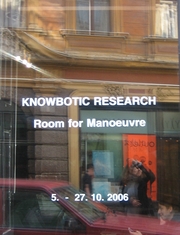| The
exhibition 'Room for Manoeuvre' features new works by Knowbotic Research
(KRcF), known for their advanced network and media projects since
the founding of the artist group in 1991. In a specially designed
audio-visual installation including four video projections, 'Room
for Manoeuvre' presents four 'vehicles'
of the that Knowbotic Research have developed for their current projects,
and places these vehicles in a series of hypothetical scenarios. The
exhibition explores the meaning of codes and actions in public spaces.
It proposes possibilities for acting through strategies of transcoding
in these spaces of power, of scientific knowledge, of surveillance,
and spaces of migration. Going beyond these possibilities, the show suggests to the audience that such 'vehicles' might in fact be used for other, self-designed purposes. The show came about as a result of an invitation by Alenka Gregoric from Škuc Gallery, almost two years ago, to curate an exhibition that would show how the divide between the so-called media art world and the contemporary art world is withering away. Now in the 15th year of their extremely fruitful collaboration as a group, recent projects by Knowbotic Research appeared as a perfect way of showing how the contemporary art discourse is no longer hung up on its former technophobia, while at the same time artists are becoming much more versed in understanding the limitations and the potential of digital and other technologies as artistic means. Presenting this show at Škuc is a great honour, both because of the gallery's fame as a home to the younger European art avantgarde, and because Ljubljana has played such a crucial role for reinventing contemporary art in the face of the network and digital culture. Andreas Broeckmann, Stefan Riekeles |
